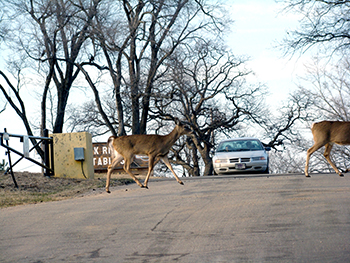Risks for Hitting Deer Increase in Late Autumn
Return to Agent Articles.  Have you been seeing more deer this fall? Or hearing about them in the news lately? At the peak of the breeding season it is not unusual to see deer at dusk, dawn or even throughout the day.
Have you been seeing more deer this fall? Or hearing about them in the news lately? At the peak of the breeding season it is not unusual to see deer at dusk, dawn or even throughout the day.
While the breeding season actually can run from October into January, the peak of the activity in the Kansas City area takes place from early November through the end of November. This increased deer activity can pose a problem for drivers in urban settings. According to the Insurance Institute for Highway Safety, an estimated 1.5 million deer-vehicle crashes occur each year in the United States. These crashes result in at least $1.1 billion in vehicle damage.
Tips for avoiding a fatal accident
What can you do to reduce your chances of being involved in a deer/vehicle accident?
- Slow down — particularly during dawn and dusk. Not only are deer more active during these low light periods, but traffic increases as well, as more people are traveling to and from work.
- If you see a deer cross the road ahead of you, be prepared to stop. Deer often travel in small groups. If you see one, there are usually more nearby.
- If a deer is spotted in the roadway, try honking your horn and flashing your lights to get it to move.
- If a collision is unavoidable, try not to swerve out of the way.
- It is better to hit the deer squarely head-on. Many drivers suffer death or serious injury when they veer into oncoming traffic or into a fixed object, like a tree or telephone pole, when trying to avoid a deer.
- Wear a seat belt — you have a much better chance of walking away from a collision with a deer if you and all your passengers are wearing seat belts. The Insurance Institute for Highway Safety found that 60 percent of the people killed riding in vehicles weren’t using safety belts.
- If you strike a deer, drive to a safe location and call law enforcement officials. Do not walk on roadways.
- Heed deer crossing and speed limit signs.
- Drive carefully in areas known to have high deer populations and in areas where you have seen deer before. Deer have regular travel patterns. If you have seen them previously in an area, they will most likely pass through that area again.